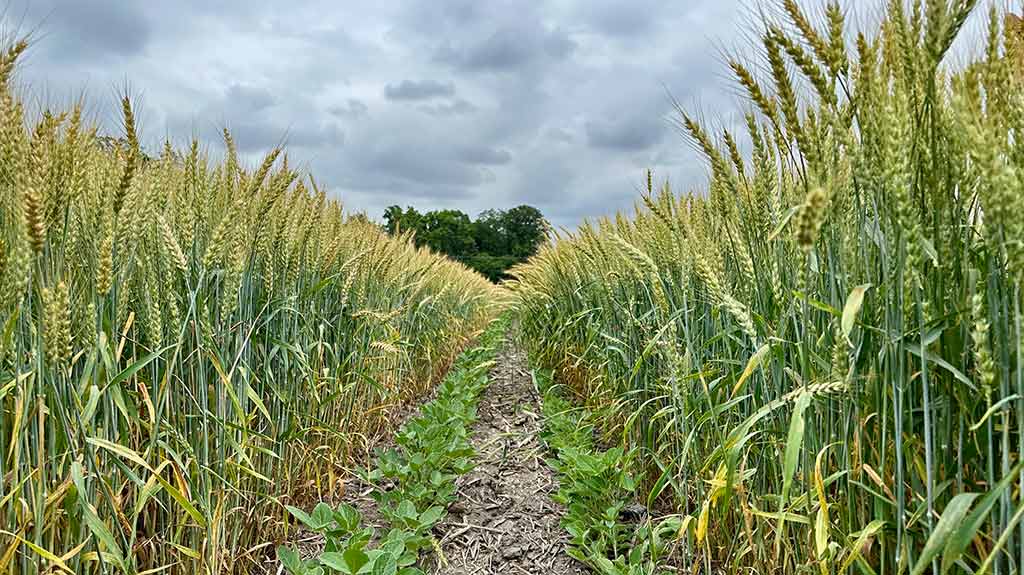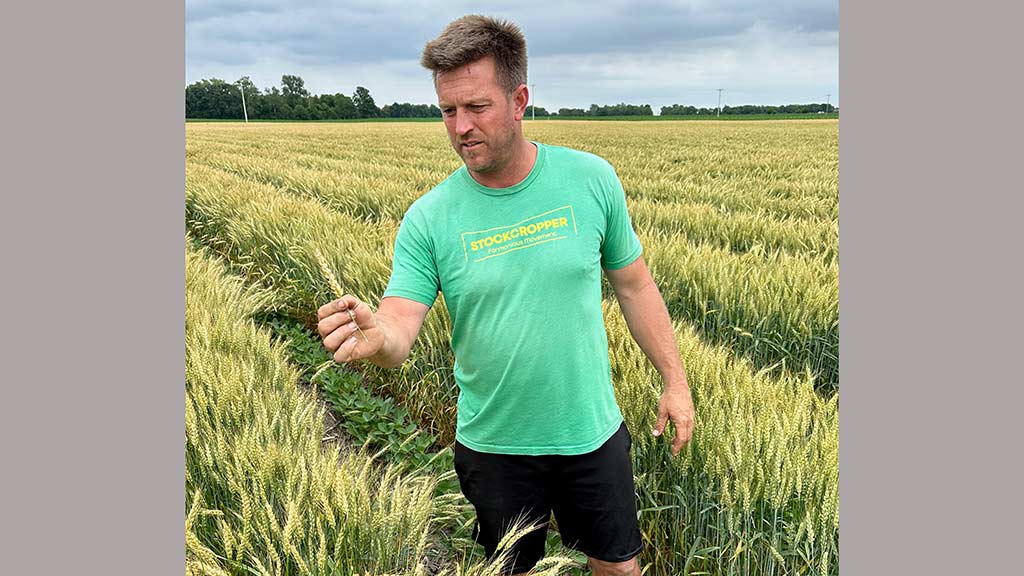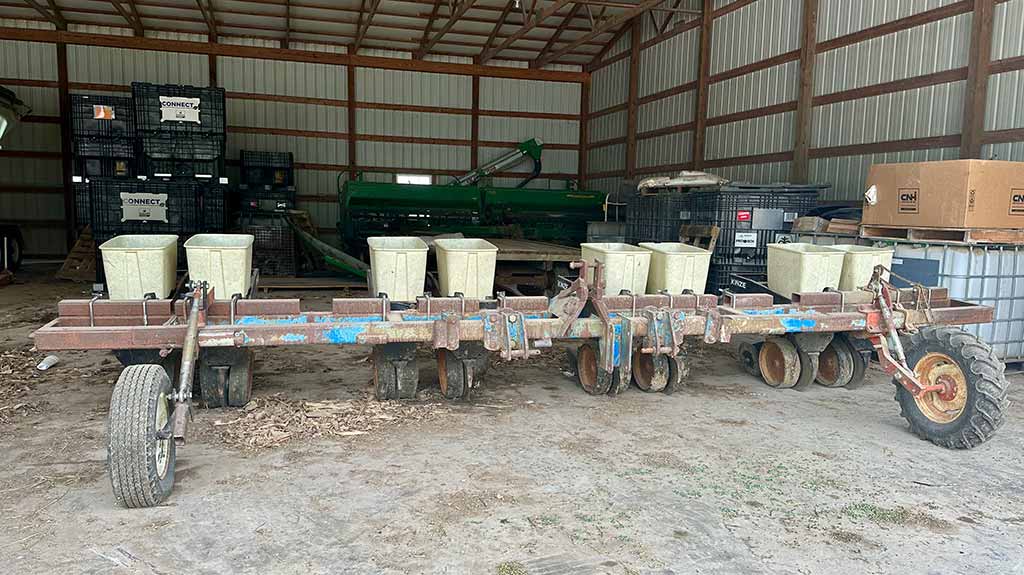How US farmer increases profitability through relay cropping
 © Mike Abram
© Mike Abram Relay cropping winter wheat and soya beans in one season could be worth at least £605/ha (US$300/acre) more for a US farmer in Indiana compared with just growing mono soya beans in the same field.
Jason Mauck – who crops about 1,200ha, near Muncie, alongside a 12,000 wean-to-finish indoor pig unit – has been fine-tuning his relay cropping system for about eight seasons.
See also: Why cultivation equipment is making a comeback on Wiltshire farm
Relay cropping is a system of intercropping, where two crops are growing together for part of the season, but planted and harvested at different times – a form of double cropping.
In Jason’s system, winter wheat is planted in strips in the autumn and harvested in July. Soya beans are planted between the wheat strips in March or April, and then harvested in October.
“At first I thought we could do everything we do with monoculture wheat and soya beans and get twice the product,” Jason says.
“Of course, that was impossible as there is only so much water and sunlight for both crops. It took about four years to figure out this equilibrium and how to start maximising the economics.”
Maximising economics
The first proper trials began in 2015, planting two rows of wheat every 750mm, which was treated with an autumn application of pig manure.
The farm has a supply of about 22.7m litres of manure from the pig unit.
“It worked well, but my wheat was too good, yielding 110 bushel/acre [7.4t/ha].
“What I figured out was if you excite the wheat in 30in [760mm] rows, it will grow laterally and capture all the light, and there wasn’t enough moisture and light for the soya beans to grow.”
After a couple more seasons of trials, he’s found that planting four consecutive rows of wheat on 190mm spacings in 1,500mm centres provides a better balance to maximise solar energy use, with the drill blocked off to create the gap to plant two rows of soya beans 500mm apart.
Fields close enough to the pig unit get manure injected between the wheat strips.
This allows him to cut seed rates by as much as 75% compared with a solid stand of 5m seeds/ha.
Where manure is not available, he reduces seed rate by about 50%.
Drilling date
Planting date is usually in late September or early October following a maize crop that has been selected for early maturity.
The bigger gap between wheat strips encourages the crop to tiller more and grow out laterally to fill the space, Jason says.
“If you give a volunteer wheat plant space, it can produce a lot of heads from a single seed, so I’m looking to exploit that to get maybe five to seven wheat heads per seed versus 1.5 heads in a mono crop scenario and create more value per seed.”
During spring, the centre wheat rows typically grow taller through competition effects, while the side rows grow laterally to create a half-circle crop architecture, not dissimilar to what you see in commercial lavender fields.
By harvest, the wheat can nearly meet across the gap above the soya beans.

Jason Mauck © Mike Abram
Soil moisture
Part of the value of the wheat is its impact in removing excess soil moisture.
This allows Jason to plant soya beans earlier than perhaps otherwise in early April, with the wheat crop creating a microclimate that also helps to protect the beans from late frosts.
But it can be a fine balance – if it goes too dry after planting, the lack of moisture can hurt the development of the bean, although usually excess moisture is more of an issue at that time of year.
“My big motive is how can I grow wheat as cheaply as possible, while trying to increase the yield of the soya bean,” Jason says.
“It’s not about maximising wheat yields, it’s about contribution margin. But that’s only important if I don’t shoot the beans in the head.
“If I can raise 70 bushels/acre [4.7t/ha] of regular beans but only achieve 35 bushels/acre [2.35t/ha] of relay beans, if I get too aggressive with the wheat and suck up too much water, I don’t gain anything because at US$14/bushel [£163/t], the maths doesn’t stack up,” he says.
Homemade planter
Earlier planting of the soya using a home-made planter gains more days for reproductive bud set and pollination, increasing yields, Jason explains.
He also gains by planting a later maturing variety than typically grown in his latitude.
“After I harvest the wheat, I empower the soya bean with three or four times more light per plant than it had been getting, so it feels it is getting a longer day. It changes its vegetative motive to stop being in competition with itself, which shortens the space between nodes.”
He believes the earlier planting, plus the extra space for the soya bean plant to grow into, lowers the time between node set, encouraging the plant to create a new node every two and half days compared with four days in a mono crop.
Maximising node numbers should help increase yield as flowers and pods are produced at nodes, providing environmental conditions are right to fill the pods.
By increasing light interception, delivering nutrients through the manure, and space for the soya bean crop to grow into, Jason believes relay crops deliver this.
“Historically, we gain four nodes on the main stem versus narrower row mono crops, but with lots more branches, branch nodes and longer pod development on each pod site.”

Home-made soya bean drill © Mike Abram
Harvest
By wheat harvest, the soya bean plant can already be as tall as the wheat crop.
Jason uses Flexxifinger pads that snap onto the combine header to compress a 600mm-tall soya bean down to just 100mm to prevent damage to the crop.
“It’s like they are doing the limbo and eventually just spring back up.”
Within a few weeks, the soya beans are meeting across the row to fill the vacated wheat gap, he says.
“It’s a bit like unzipping your trousers after Thanksgiving lunch, and letting your stomach pop out – those beans will really expand and it takes no more than 20 days for the beans to zip back shut [across the gap].”
Jason thinks the wheat straw helps reflect sunlight back up into the lower part of the soya bean plant further improving light utilisation, as well as acting as a moisture conserver.
“Each plant yields more because it gets more light, carbon dioxide and water.”
This season
This year’s relay crops have been in two fields – one with manure applied and one without.
Both wheat crops were harvested in early July with the manured wheat achieving 100 bushels/acre (6.7t/ha) and the non-manured crop 70 bushels/ac (4.7t/ha).
The 100 bushels/acre wheat is well above the 80 bushels/acre (5.4 t/ha) average wheat yield for Indiana.
Potentially, that might impact on soya bean yields.
“With every three to five bushels of wheat, it extracts one acre inch of water – we average around 42in [1,070mm] of rain per year.
“If I grow higher yielding wheat, I’m going to have less moisture for the soya beans.”
Income
He’s hopeful the relay cropped soya beans on that field will reach 70 bushels/acre (4.7t/ha), which would provide a combined income of US$1,614/acre (£3,254/ha).
With growing costs of about US$250/acre (£503/ha), that would provide a gross margin of £2,753/ha compared with £1,886/ha for mono crop soya beans yielding 80 bushels/acre.
On the second field, the difference between mono crop and relay crop is likely to be a bit lower – about US$246/acre (£496/ha), he calculates – if both soya bean crops yield 60 bushels/acre (4t/ha).
“In a wet year, we’ve broken state records for soya bean yields, but the wheat didn’t do as well that year.
“But you can win either way, especially as we’re planting fewer seeds using manure instead of commercial inputs, lowering input costs to where it doesn’t take much yield to create contribution margin.
“If I can get two crops out there, I can kind of hack the system with lower inputs and slightly lower yields, but aggregately get more,” he concludes.
Could relay cropping work in UK conditions?
Ripening a second crop after wheat is one of the key challenges that make a similar system challenging in the UK.
“The reason it works with wide rowcrops in Indiana is they have more heat units in summer to ripen crops later in summer,” notes Kent grower Andrew Howard, who studied different types of intercropping for his Nuffield Scholarship in 2016.
Indiana lies on approximately the same latitude as central Spain and southern Italy, some 10 degrees further south than southern UK.
“It’s pretty marginal for ripening crops once you get into September in the UK.”
Potential second crop options that might work in the UK are buckwheat, linseed or millet.
Wildfarmed’s Andy Cato was planning to try relay cropping with buckwheat this season, but the weather interfered with his plans.
“I’m sure it can work,” he says. “The potential issue is that I don’t want to leave soil in the inter-row bare until the relay crop is seeded, which would mean establishing a cover crop which can then give way to the relay crop.
“Terminating that cover crop and any weeds that have come with it might be tricky without using band sprayed herbicides, which we don’t use.”
An alternative option to terminate the cover crop would be an inter-row rotavator, he says. “I’ve tried one, but it is slow going.”
Machinery
Finding machinery to establish a crop in a relay system as well as it could be conventionally is also a challenge, says Lincolnshire farmer and machinery manufacturer George Sly.
“It’s all home-made, even in the US, and for us to develop something costs hundreds of thousands pounds, so you have to be sure there is a market.”
George has trialled growing winter wheat in 50cm triple rows on his farm, which didn’t drop in yield, he says.
“Winter wheat will tiller out and cover a remarkable area if you give it light and space, but I’ve found the complete opposite with spring cereals.”
But finding a second crop that would be harvestable in a relay crop system in the UK is very difficult, he agrees.
Wide rows
Shropshire grower John Bubb has developed a 50cm wide row strip-till system for the non-potato crops in his rotation, says his agronomist, Ed Brown of Hutchinsons.
The starting point was recognising wide row strip-till would suit both poppies and OSR.
Wheat made less sense, Ed admits, but three separate trials last season – where the wheat was drilled in a 10cm band – gave yields broadly the same as the farm standard.
“The wheat definitely tillers more, although it doesn’t completely fill the gap between the rows,” Ed says.
In the first wheat crop after potatoes, clover is now inter-row seeded with a Weaving IR drill in June, in the gap between the wheat bands after any herbicide applications have been completed.
The plan is for the clover to then stay in place until the next potato crop in five years.
“It’s not there to harvest, but acts as a companion that helps soil structure, contributes to nitrogen and weed suppression.”
OSR will then be strip-tilled next season in the same bands as the wheat, with the clover left as a living understorey.
Autocasting
Other relay cropping opportunities in UK conditions include Autocasting cover crops or OSR into standing wheat or barley crops.
Drone firms are also beginning to offer similar services.
Both consistency of germination and slug control can be challenges with this system, Andrew notes, who has used both an Outcast system attached to a sprayer and Autocast on the combine to establish cover crops or OSR in standing or just harvested crops.
It can be a bit hit and miss in terms of consistency of germination, he says of his Autocast system, which he is using to establish a catch crop off the combine this year. “You need moisture.
“The ones I did in July were too wet to roll, but ideally you go through with the rolls straight after to help with a chit and maybe to get some grassweed growing,” says Andrew.
Slug challenge
The issue with broadcasting seed into standing crops is that slug control becomes difficult because of the risk of slug pellets getting caught in wheat ears, he adds.
Those various challenges with relay cropping are why all four currently believe that more traditional bi- or polycrop systems where the intercrops are harvested together are more likely to be successful in UK conditions.

